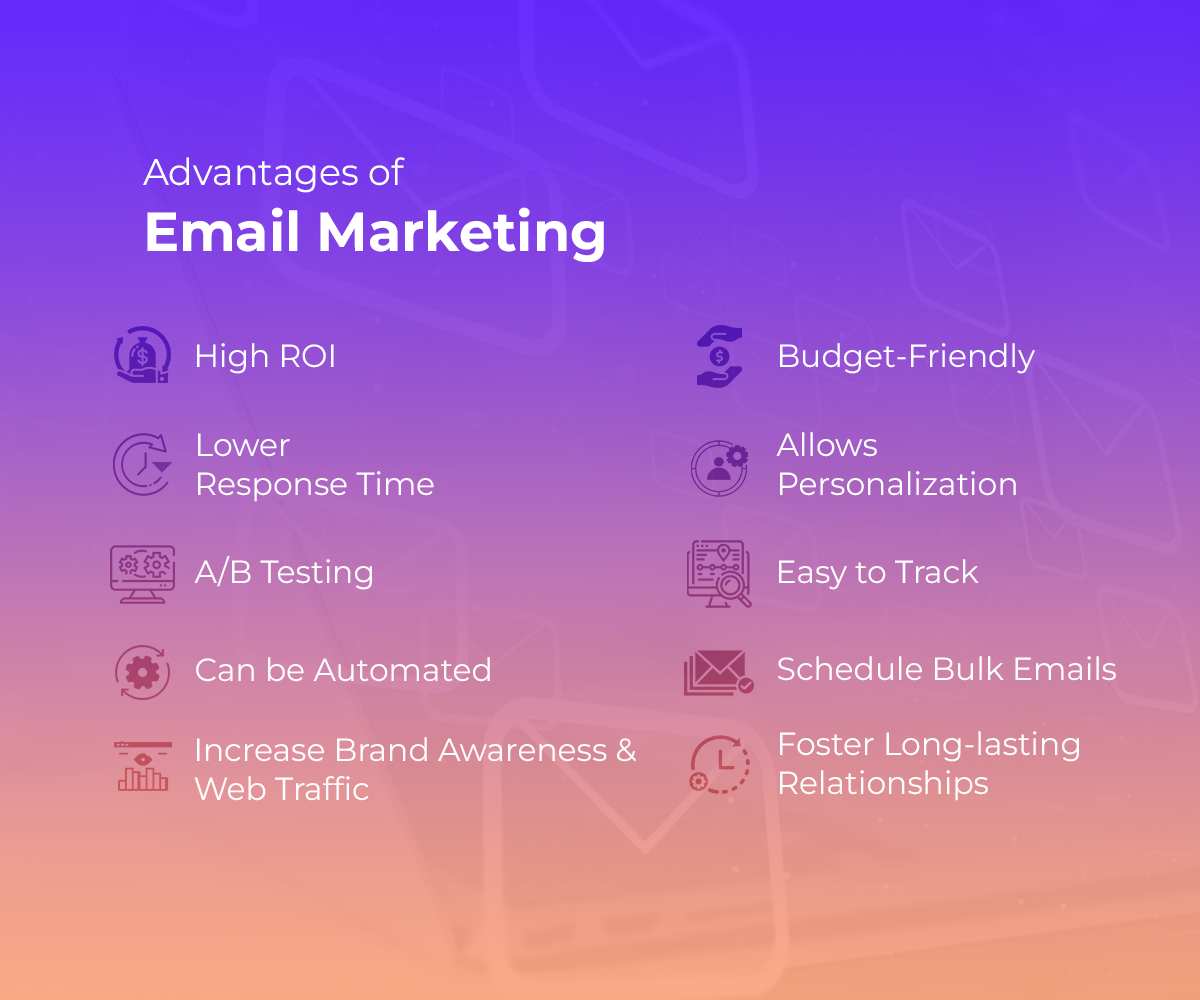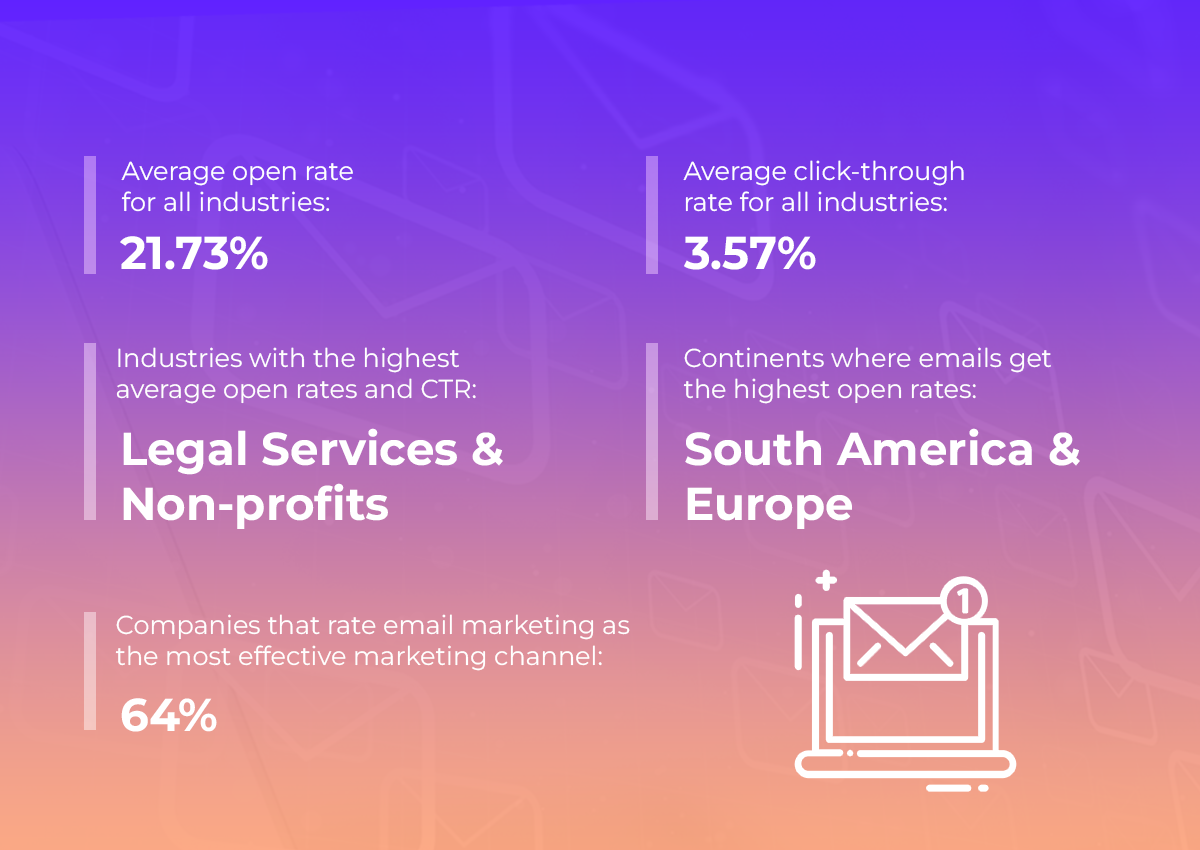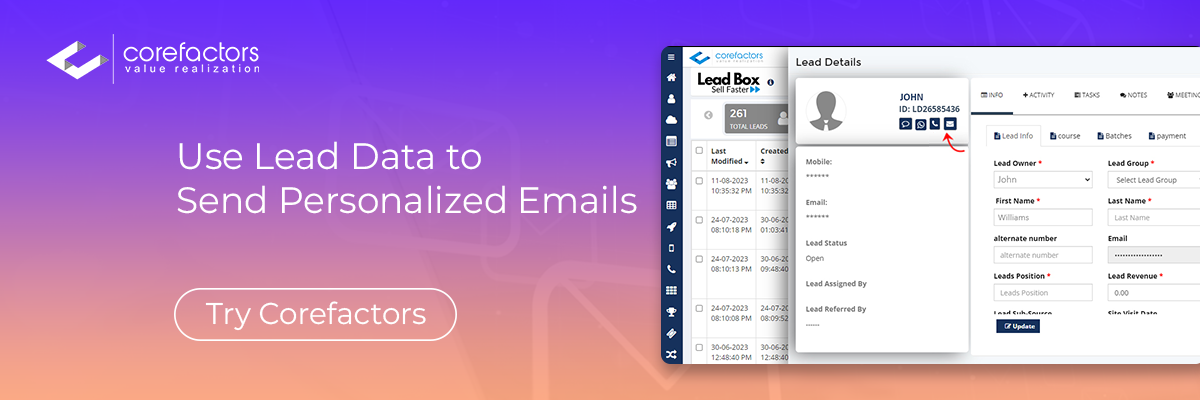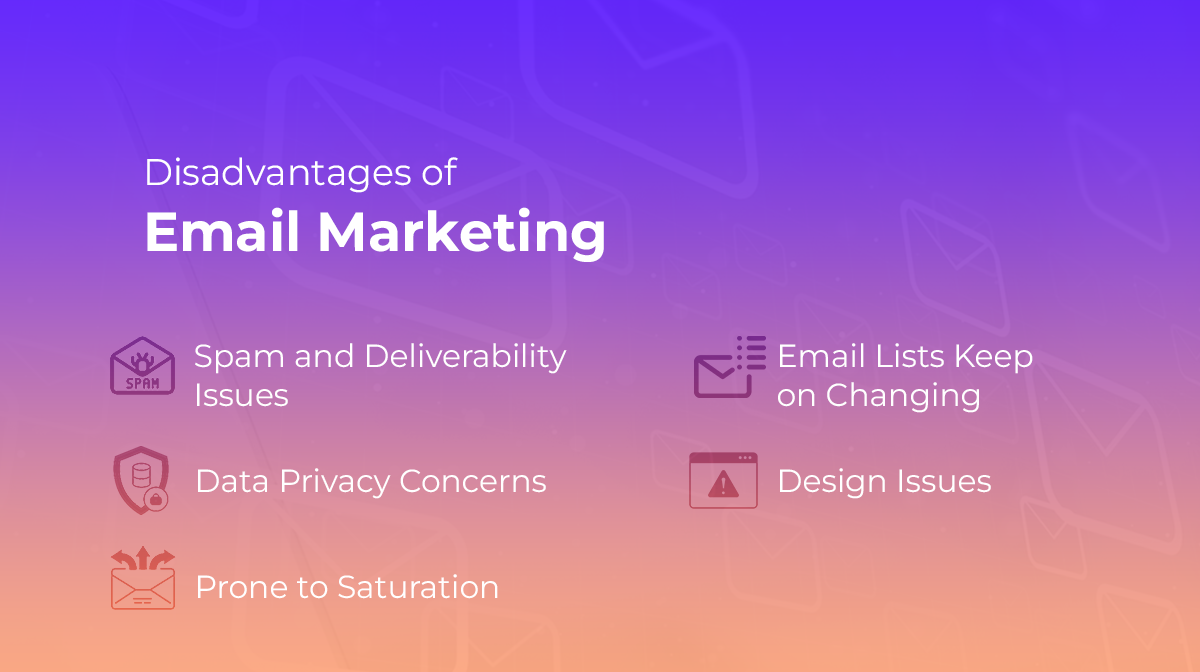Can you imagine a marketing team that does not use email marketing?
Not likely.
By 2026, the number of global email users is predicted to reach up to 4.6 billion. Who wouldn’t want to tap into this market?
Like every other marketing channel, we also have the advantages and disadvantages of email marketing. This blog will cover points that will help you understand how your business can navigate email marketing with all its advantages and disadvantages.
What is Email Marketing?
Email marketing is a method of reaching out to your target audience through emails. The content of these emails can be anything from product updates and promotional offers to regular newsletters.
The purpose of email marketing is to establish and nurture a relationship with your audience or prospects. Emails with relevant content can have the power to capture attention and shorten your sales cycle.
The next section of this blog sheds light on some advantages and disadvantages of email marketing.
Email Marketing Advantages
The advantages of email marketing have been covered in this list.

- High ROI
Email marketing does not need much money but provides good results. It enjoys one of the highest ROI rates among different digital marketing channels.
Email marketing ropes in anywhere between $36 - $40 for every $1 spent. Such a high ROI makes this marketing method worth every penny.
As you will see in the other points, the high ROI is only the cherry on the cake.
2. Budget-Friendly
Email marketing is one of the most affordable ways to reach out and connect with your target audience. You can send out emails for free from your existing email account. One thing that you have to keep in mind is that these emails must be short. If you've already got some on your hands, summarize them before sending.
The cost factor comes into the picture when you want additional features like scheduling bulk emails in advance and automating the email-sending process. Multiple marketing tools come with free trials and paid plans for taking your email marketing activities up a notch.
There are no extra costs, such as advertising fees and the costs associated with print media. You can send an unlimited number of emails at a very low cost.
Email marketing has an advantage over other forms of marketing, especially, when it comes to its low investment cost. It helps small businesses to run a marketing campaign on limited resources. On the other hand, larger businesses can make their email marketing efforts more targeted by allocating a slightly higher budget.
3. Lower Response Time
Email marketing is a form of direct marketing and enjoys the advantage of having a lower response time as compared to social media and other forms of marketing. Additionally, the integration of social media scraping techniques can enhance email campaigns by providing valuable insights into customer behavior and preferences
Having 20,000 followers on LinkedIn is not the same as having 20,000 subscribers to your business newsletter. When you post something on LinkedIn, not all 20,000 accounts will see the post as they will not get a notification (Unless they have turned that feature on for your page).
But when you send out a newsletter to 20,000 email subscribers, their inbox will reflect a new email from your business and they are more likely to open and interact with the message. This interaction can be through clicks embedded within the email or just visiting your business page.
Emails still enjoy a higher open rate and click-through rate.

4. Easy to Track
An email marketing activity does not end with sending emails to a curated list of prospects. You should also know what happens to those emails.
Information like who is opening your emails, how many and who is unsubscribing, how many are clicking on the link in the email, etc. help get a better picture of whether your email marketing campaign was a success.
By keeping track of these open rates, click-through rates, and conversion rates, you can better understand if your emails are resonating well with the audience and optimize the content accordingly.
This data also helps in understanding audience preferences and further segmenting your email lists for more targeted campaigns. For example, a higher unsubscribe rate means the content you sent out did not align with what the target audience wants to see. Tracking accounts that have clicked on links within the email will help you know what exactly they like to interact with and provide them with content along similar lines in the future.
5. A/B Testing
A/B testing or split testing is a method that allows you to send two versions of the same email to different audience segments. By doing so and tracking the email performance, you can determine which works better.
This method allows you to better experiment with the email content and design by comparing the performance. You can determine which subject line is more likely to have a higher open rate and optimize them accordingly.
Strike the right balance by testing the frequency of your emails. Figure out whether your desired audience responds better to a higher or a lower frequency.
6. Allows Personalization
The major advantage of email marketing lies in its ability to collect data that can help you personalize the email content. By segmenting your audience based on different parameters like their socio-economic background, buying behavior, preferences, etc. you can come up with relevant content that caters to each such segment.
Personalization increases the chances of conversion. A CRM like Corefactors comes with both lead management and marketing personalization capabilities. With advanced settings, you can draw data directly from lead lists to personalize the email content being sent.

Users are more likely to respond to content that addresses their needs. Personalization boosts the effectiveness of your email campaign by making the content more user-specific and relevant.
incorporate UGC (user generated content) into your email marketing campaign to create personalized narratives which ensure that your emails resonate on a more individual level with each recipient.
7. Can be Automated
The best email marketing advantage is undoubtedly the capacity of automation. It reduces the need for manual intervention and saves time and resources by ensuring a consistent flow of communication. The marketing team can instead focus on other strategic activities.
As mentioned in the previous point, automation allows the segmentation that is required for email personalization. Automated workflows can help nurture leads at various sales cycle stages, nudging them closer to conversion.
You can also leverage automation to set up triggers based on user action and behavior.
8. Schedule Bulk Emails
Scheduling your emails in advance comes with the advantage of sending out the emails at optimal times when your audience is most likely to engage. It comes in handy especially when you have a global audience where the optimal times for each demography can be different.
You can effectively organize and coordinate your campaign effectively by scheduling emails in advance. Some examples of this scenario include sending out emails for seasonal promotions, product launches, or time-sensitive announcements.
9. Increase Brand Awareness and Web Traffic
Increase brand awareness by subtle tweaks in your email content and design. Ensure your emails remain consistent with your brand messaging, colors, logos, and overall tone and personality.
By regularly sending engaging content like newsletters, updates, and exclusive offers, cultivate a positive relationship with your audience.
You can also use emails as a tool to direct the reader to your website through links.
Increase clicks and revenue on your website to make the affordable hosting pay off.
Accompany the link with a clear CTA and also include different buttons for your social media handles. However, make sure to use an SPF generator as it can help ensure your emails land in inboxes and not spam folders and prospects don't view those links as something suspicious.
10. Foster Long-lasting Relationships
Through regular communication via email campaigns, build reliable relationships with your audience for long-term success.
Add value to your products and services by sharing insights through newsletters. This demonstrates your commitment to ensuring the users make the most informed decisions when it comes to your product or service.
Customers appreciate businesses that not only send emails when they have something to promote. Share content that allows two-way communication. Foster a sense of partnership and mutual understanding.
Email Marketing Disadvantages
While email marketing is a powerful tool, it also comes with its own set of pros and cons. Mentioned below are some disadvantages of email marketing.

- Spam and Deliverability Issues
You might face deliverability issues when your marketing emails are flagged as spam by the receivers. Your audience may even delete the email without interacting with it. This is especially true in the case of cold emails.
If your email content is not relevant to the audience, you run the risk of getting complaints and ending up in the spam folder.
Using images might make your email look attractive, but keep the image-to-text ratio in mind. Spammers often use images to hide content they do not want to be flagged. Emails containing a high image-to-text ratio run the risk of being categorized as spam by these filters.
2. Design Issues
A poorly designed email can end up looking messy and unprofessional. Emails with large textual content may not get the attention of readers. Add formatting issues and poor grammar to the mix, your brand loses credibility before it can foster any relationship with the consumer.
Unlike WhatsApp and other social media marketing channels, there is no option to edit the email once it has been sent.
A design that looks good on a laptop, may be misaligned when viewed on a mobile screen. These factors need to be kept in mind before hitting that send button for your email marketing efforts to be a success.
3. Data Privacy Concerns
Data privacy is a serious matter. Email marketing practices often rely on collecting personal data to enhance targeting through personalization. As such, marketers should also bear the responsibility of protecting the data of their subscribers.
Trust issues and legal consequences may arise from data breaches or mishandling of subscriber information.
Be extra vigilant and GDPR compliant. Follow transparency in subscriber data usage and storage practices.
4. Email Lists Keep on Changing
The email list of prospects you collected today after allocating resources for data scraping might not be valid after six months. Several things can happen at this time for the email list to lose its relevance.
The target audience might change their email addresses, or worse, no longer be your target audience. To counter this, you need to perform regular list maintenance using email verification tools. Remove those who have pressed unsubscribe from the list or re-purpose the content to gain their attention.
5. Prone to Saturation
It is important not to go overboard with your email marketing campaign. Imagine receiving 30 emails, one for each day a month, promoting a product or service. Even if you were interested earlier, this will only make you feel as if the business is forcing you to buy what they are offering and you will hit that dreaded unsubscribe button.
Find that magic number that keeps your audience interested and engaged without being overwhelming.
Key Takeaways
Now that you have information on the advantages and disadvantages of email marketing, explore different options and choose wisely.
Email marketing was and remains one of the most opted-for forms of digital marketing. It can act as an additional sales channel by driving traffic to your website and fostering long-lasting relationships with your customers.
Email marketing also has some disadvantages in the form of being prone to be labeled as spam and other deliverability issues. If not targeted properly, the email content might not resonate with your audience, disengagement rates can go up.
In the end, it is all about balance!







